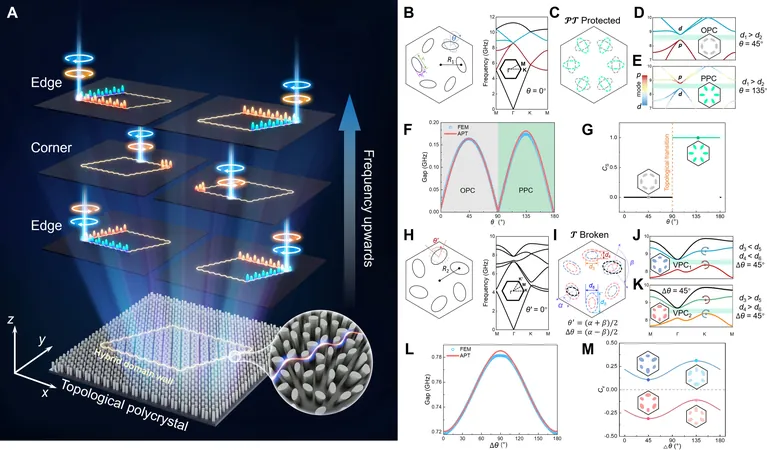
Revolutionizing Photonics: The Game-Changing Topological Polycrystal
2025-05-08
Author: Jia
Harnessing Light for the Future
In the rapidly evolving world of integrated photonics, controlling the flow of light—whether it's contained in tight spaces or traveling freely—remains a top priority. The emergence of advanced multi-channel optical waveguides and couplers is set to transform traditional electronic circuitry. These developments promise unparalleled speed, bandwidth, and efficiency across the optical and microwave realms.
Navigating Challenges in Complexity
As on-chip systems grow more intricate, challenges around stability and manufacturing imperfections loom large. Ensuring reliable performance is absolutely paramount for real-world applications.
The Demand for Complexity
With the insatiable demand for high-capacity information processing, the push for more sophisticated photonic integrated circuits (PICs) has gained momentum. Topological photonics emerges as a beacon of hope, offering a robust response to the challenge of defects.
Breaking Limits with Hybrid Topology
Traditional topologically-protected circuits, which capitalize on two-dimensional structures, face limitations in supporting edge states. To tackle this, researchers have turned their attention to hybrid topological effects—melding different topological phenomena within a single framework.
Introducing the Configurable Topological Photonic Polycrystal
In an exciting recent breakthrough, scientists have unveiled the concept of a configurable topological photonic polycrystal. This innovative dielectric metasurface utilizes tunable elliptical components and a novel coupling technique that merges pseudo-spin and the valley Hall effect, creating a powerful platform for advanced photonic control.
Revolutionizing Band Gap Calculations
A pivotal aspect of this research is the development of a new perturbation theory that focuses on structural orientation angles. This allows for swift calculations and adjustments of photonic band gaps, effectively tuning the system's properties by manipulating these orientation angles.
New Dimensions in Photonic Design
The team's innovative approach combines two-dimensional Bloch momentum space with one-dimensional orientation angles to create a three-dimensional synthetic space. This capability enables the computation of continuous topological invariants and offers a cutting-edge theoretical framework for exploring the system's varied topological properties.
Comprehensive Insights into Photonic States
By meticulously analyzing the hybrid dimensions, researchers identified how bulk, edge, and corner states evolve as orientation angles change. This analysis unravels the mysteries behind the dynamic reconfigurability of the hybrid topological polycrystal.
Setting New Standards with Local Quality Factors
A groundbreaking local quality factor (QL) was introduced to evaluate the performance of hybrid eigenmodes within band gaps, refining the methods for assessing the effectiveness of these sophisticated photonic devices.
Validation in Action
Experimental validation of this paradigm-shifting approach has been achieved, demonstrating high-contrast multi-band edge states and advanced corner states in an integrated circuit setting. This innovation could revolutionize on-chip logic gates and couplers, exponentially increasing the potential for high-density optical communication.
The Road Ahead: Exploring New Frontiers
Looking forward, researchers are excited about the prospect of delving into nonlinear effects within hybrid topological polycrystals. This exploration aims to enhance their multimodal and multi-band capabilities, opening up uncharted territories in both classical and quantum photonics.




 Brasil (PT)
Brasil (PT)
 Canada (EN)
Canada (EN)
 Chile (ES)
Chile (ES)
 Česko (CS)
Česko (CS)
 대한민국 (KO)
대한민국 (KO)
 España (ES)
España (ES)
 France (FR)
France (FR)
 Hong Kong (EN)
Hong Kong (EN)
 Italia (IT)
Italia (IT)
 日本 (JA)
日本 (JA)
 Magyarország (HU)
Magyarország (HU)
 Norge (NO)
Norge (NO)
 Polska (PL)
Polska (PL)
 Schweiz (DE)
Schweiz (DE)
 Singapore (EN)
Singapore (EN)
 Sverige (SV)
Sverige (SV)
 Suomi (FI)
Suomi (FI)
 Türkiye (TR)
Türkiye (TR)
 الإمارات العربية المتحدة (AR)
الإمارات العربية المتحدة (AR)